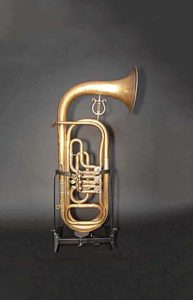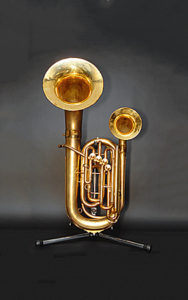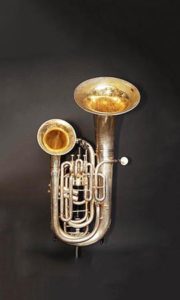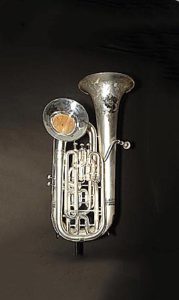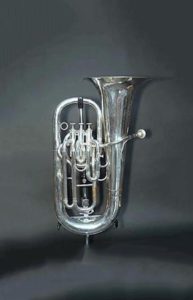Tenor Horns / Baritones / Euphoniums
The tenor horn is a valved brass instrument pitched in Eb. It has a predominantly conical bore like the baritone horn and flugelhorn. It uses a deep funnel- or cup-shaped mouthpiece. It was first developed in the 1840s by the Belgian instrument maker Adolphe Sax. Today, it includes the baritone horn and euphonium.
The baritone (horn) is a low-pitched, lip vibrated aerophone, that belongs to the saxhorn family. It has piston valves with a bore that is mostly conical (like the flugelhorn and alto tenor horn), but narrower than the euphonium. To play, one buzzes their lips into a wide-rimmed cup mouthpiece. Like the trombone and euphonium it may be played in bass clef as a non-transposing instrument or in treble clef as a transposing instrument. The term baritone originates from the Greek βαρύτονος (barýtonos), meaning “heavy sounding,” identifying a vocal range between the tenor and bass. The baritone horn is pitched in concert B♭, meaning that when no valves are pushed down, the instrument will produce partials of the B♭ harmonic series.
The euphonium is a lip vibrated aerophone that resembles a small tuba of tenor pitch. It is played mainly in military and brass bands. Like the baritone, it produces partials of the Bb harmonic series and has the same range, as both have a nine-foot-long main tube. However, the euphonium has a more conical bore and less of the cylindrical and smaller bore of the baritone. The name euphonium comes from the Ancient Greek word εὔφωνος euphōnos, meaning “well-sounding” or “sweet-voiced” (εὖ eu means “well” or “good” and φωνή phōnē means “sound”, hence “of good sound”). The euphonium is considered either a transposing or non-transposing instrument.

